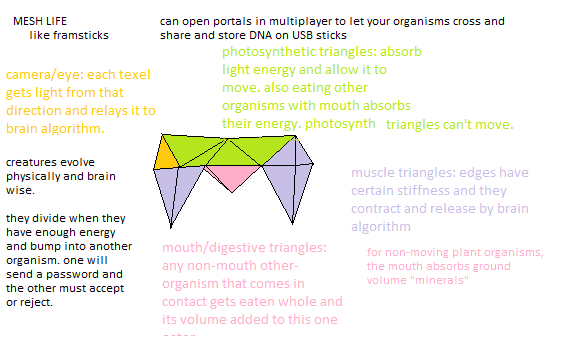Here is another idea I had. http://23.226.230.153/proj1/ml/ It would've used simplified physics, eg, for rotations and rotational response to different interpretation with the ground or other meshlife being line intersections or polygonal volumes, it would for example gotten the average point or calculated the centroid of the volume, and applied a rotation and translation force that would've been divided such that, it's center of mass being calculated as the distribution of surface areas of the triangles, or volumes if I could do that and figure out how to do that, and any stepping and locomotion or force pushing off the ground would been simplified. Basically, instead of simulating flexible solids, it would use vertices and triangle areas, and stresses and elasticity factors of edges between vertices. And muscle movement would've been based on stretching and flexing or extending these elastic edges and applying force to them. The phenotypal DNA would have been a code that started with a tetrahedron (a 4-triangle polyhedron), that has numbered edges and triangle sides, which would been nested, to give the next occurance of a split or division of triangles, between which edge and vertex, for example, and decided what kind of triangle that would be in the leaf (muscle, sensor, etc.) And also in that DNA along with each division would be specified the amount of space to give all the new sides proportionally to the parents or how much space there is, so it would be easy to space protrudences, and 3D shapes, and interesting mutations, and along with in-born inflexibilities or proportions along edges that don't match, there wouldn't been in-born stresses applied there, which might affect muscle forces, or physics. The brain could've also evolved with a DNA code, using my new neuro-hash approach that I use now and invented a while ago.
Advertisement
Latest Entries
System for mmo
2087 views
not ideas [edit]
2169 views
Ideas [edit]
2713 views
job
2246 views
subfield [edit3]
2258 views
subfield
2038 views
physics classroom
2606 views
screenshots
2133 views
Advertisement
